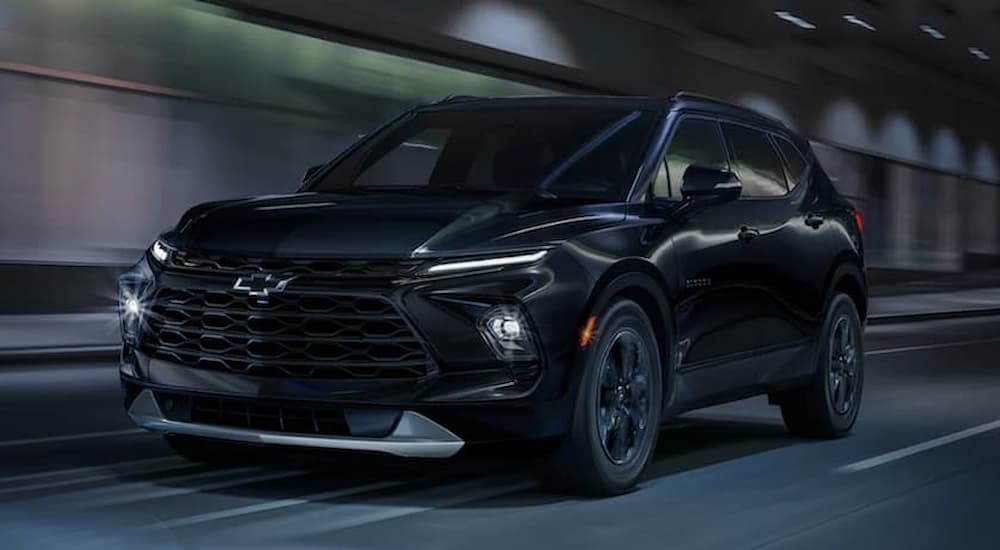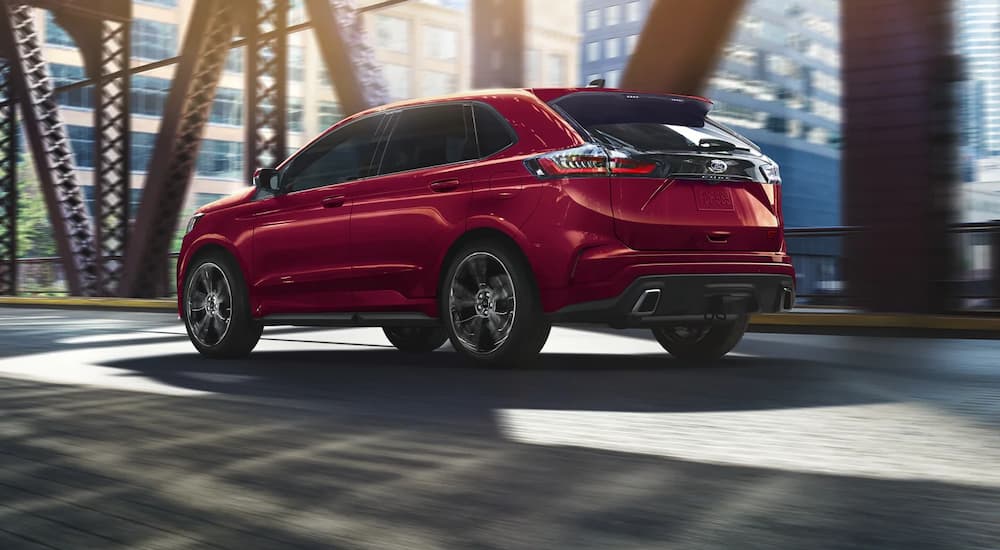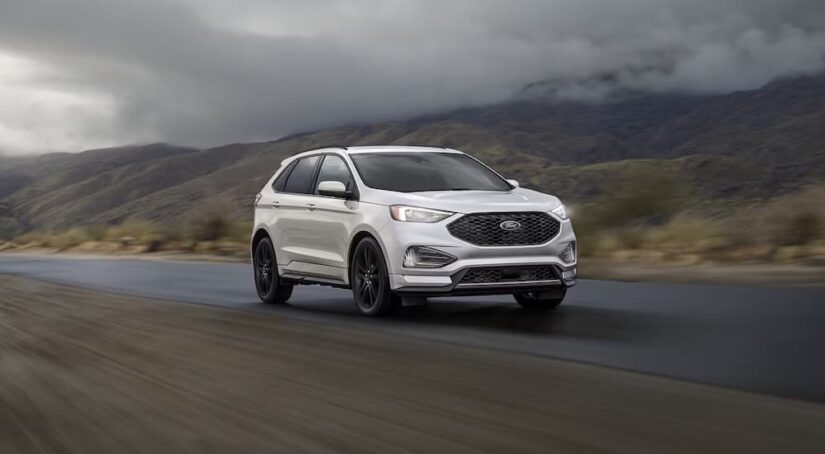Crossover SUVs are all the rage. Everyone and their mother seems to be itching to buy one, which is no surprise when you consider their versatility and improved fuel efficiency. Their appearances have evolved over the years, too; now, many look classy or sporty. No one feels embarrassed to be seen in a crossover and they set the trends as much as they follow them while offering a smooth ride.
Two of the most interesting midsize crossover SUVs come from Ford and Chevy; the 2023 Ford Edge vs 2023 Chevy Blazer is an interesting competition to consider as they both aim for the same type of buyer. At a glance, the SUV you go with may seem like it comes down to just aesthetic preferences or brand loyalty. Yet, there are more differences between the two than might first meet the eye. A careful look at both shows why the 2023 Ford Edge is the SUV to go with for many drivers. That’s not to say the Chevy Blazer is a disappointment, but between the two, the Edge has some characteristics that might better please the daily driver.
Let’s take a look at the Edge and the Blazer to see how the Edge wins out.
Fuel Efficiency
We’ll start with one area where Chevy has certainly done things right since the efficiency of the Blazer is quite impressive. With its standard engine (more on engines in a moment), the Blazer gets an estimated 22 MPG in the city and 29 MPG on the highway. An available engine for the Blazer delivers more power but comes with reduced efficiency, so if this is the biggest concern for you, then the standard powertrain is the way to go.
By comparison, the standard engine for the Ford Edge comes in with an estimated 21 MPG in the city and 28 MPG on the highway, which you can see is just slightly less than Chevy’s standard engine. This translates into about 2 MPG of less estimated combined fuel economy for the Edge, though the difference is so minimal that you probably won’t ever experience it. Estimated ratings for fuel economy can be helpful, but real-world conditions are notorious for throwing those numbers right out the window.
In other words, the Chevy Blazer wins out on paper, but in practical use, both vehicles get essentially the same overall fuel efficiency. In both cases, you’ll get a lot of driving done without stopping for gas, and that’s what’s most important. The differences we’ll see below, on the other hand, give the Ford model a clear edge.
Engines and Performance
The Ford Edge comes with a 2.0L Turbocharged I-4 engine that delivers 250 hp, which comes paired with an eight-speed automatic transmission. Even as a standard engine, this is plenty of power for a crossover like this and it makes it a lot of fun to drive. This engine gives you a bit of get up and go in the Edge, which you’ll like when you’re merging onto the highway. If you aim for a higher trim, you can have a powertrain that puts out an impressive 335 hp thanks to a 2.7L V6 engine. It takes no time at all to rocket from 0 to 60 and provides the Edge with a sporty feel.
The Blazer checks in a little under these numbers. It has a 2.0L Turbocharged engine that gives you 228 hp. A higher trim can boost that up to 308 hp for a zippier driving experience. Not bad results, by any means, but it comes a little short of what the Edge brings to the road. For performance, the Edge wins first place. I wouldn’t be upset driving the Blazer, but I always like the comfort of knowing entering the highway won’t be stressful if I have to accelerate quickly. No one wants to be the SUV waiting forever for a break in highway traffic.

Interior Cargo Space
One of the prevailing reasons crossovers are attractive is that they let drivers pack in what they need so they don’t have to rely on two cars for a trip or leave behind luggage when heading out on a cross-country journey. With a crossover SUV, you should be able to take whatever you need for your excursions; that’s why you get one, right?
Ford’s Edge has a structure that allows you to maximize space. Behind the second row of seats, you have 39 cu.ft. of cargo space. If the second row of seats is down, then this cargo room increases to 73 cu.ft. of volume, almost doubling the amount. The Edge also has storage cubbies where you can place any loose items that you don’t want banging around the SUV during your trip. This amount of cargo space is great for running errands or getting everything your kid needs with them to school in the morning.
Once more, the Blazer does well in this category but not quite as well as the Edge (you might be noticing a pattern). The Blazer allows for just over 30 cu.ft. of cargo volume behind the back seats. With the back seats down, the cargo volume increases to about 64 cu.ft. While these might not sound like a huge difference from the Edge’s numbers at first, anyone who has had to move a bit of luggage can tell you that an extra 8 cu.ft. of volume can make a big difference.
Exterior Design and Style
Both of these SUVs look great on the road and no one is going to be embarrassed to be seen behind the wheel of either of them. That being said, there are some notable differences between them in overall looks and how well you can customize each model. For example, the Ford Edge comes with nine exterior color options, while the Blazer has just eight. If you’re anything like me, then you like having the ability to personalize your vehicle; having a range of colors on offer makes an SUV more desirable to me, plus there are significant differences between these hues.
Versatility continues with the number of trims offered for each of these models. Both the Edge and the Blazer have several on offer, although the Edge comes with one more than the Blazer, continuing its tradition of just edging out (no pun intended) the Blazer. In terms of appearance, your preferred aesthetic is likely going to decide for you, but I do think the Edge makes a better case for itself. The grille on the Edge is better integrated into the front while the Blazer’s grille is too dominant for a midsize, looking a little bit like something that belongs on a pickup instead of a crossover SUV. The Edge’s front ends up looking like a mischievous grin while the Blaze’s looks like a scowl.
Some drivers may certainly prefer the latter, but I feel the former better represents how a crossover should look. Again, the exteriors of both are great because Ford and Chevy make excellent, quality vehicles. But for my money, the Edge takes the win again.

Advanced Safety Features and Ratings
When looking at any vehicle, nothing is more important than safety; in our age of rapidly-advancing technology, there’s no excuse for a vehicle to have anything less than a top-tier safety system. Both the Edge and the Blazer have excellent safety features, and you can feel comfortable and secure in either crossover. Ford and Chevy have put time and effort into making certain that their SUVs keep you and your family intact.
The Ford Edge and the Chevy Blazer both have integrated warning systems for front collisions and lane departure alerts. They also feature crash imminent braking. With this, the SUV begins to slow when its sensors register that a collision is likely to occur, giving you an extra second of braking time since it takes a moment for your foot to hit the brake.
The Edge receives a five-star rating from the National Highway Traffic Safety Administration (NHTSA) as does the Blazer. However, the NHTSA rates the Edge’s safety programs higher, ranking the Edge’s dynamic brake support as superior to the Blazer’s. The Blazer’s dynamic brake support does not meet the NHTSA’s highest criteria even on the Blazer’s higher trims. For that reason alone, the Edge becomes the better buy for safety purposes.
The Conclusion is Simple
The Ford Edge ends up being the better buy. While the Chevy Blazer has plenty to offer and I don’t think anyone will be despondent over owning one, in each category, the Edge has shown itself to be superior. While you may say the differences are small, they add up to a lot in the end. When you buy your next SUV, you no doubt hope to keep it for a while. The Edge’s superiority becomes even more important in the long run as you enjoy terrific fuel efficiency, advanced performance, and more ways to personalize your ride. No one wants an SUV that doesn’t reflect themselves to some degree; by giving you more color and trim options, the Edge allows you to enjoy an SUV that matches your personality and your lifestyle. Combine that with superior safety features and you’ll be happy to own a 2023 Ford Edge for many years to come.



